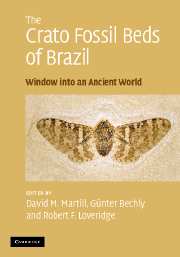Book contents
- Frontmatter
- Contents
- Contributors
- Preface
- Acknowledgements
- Part I The Crato Formation Konservat Lagerstätte
- Part II The invertebrate fauna
- 7 Taphonomy and preservation of Crato Formation arthropods
- 8 Chilopoda: centipedes
- 9 Arachnida: spiders, scorpions and allies
- 10 Crustacea of the Crato Formation
- 11 Insects of the Crato Formation
- Part III The vertebrate fauna
- Part IV The flora
- Part V Miscellanea
- Appendix: species list for the Crato Formation
- Systematic index
- Plate section
- References
8 - Chilopoda: centipedes
Published online by Cambridge University Press: 22 August 2009
- Frontmatter
- Contents
- Contributors
- Preface
- Acknowledgements
- Part I The Crato Formation Konservat Lagerstätte
- Part II The invertebrate fauna
- 7 Taphonomy and preservation of Crato Formation arthropods
- 8 Chilopoda: centipedes
- 9 Arachnida: spiders, scorpions and allies
- 10 Crustacea of the Crato Formation
- 11 Insects of the Crato Formation
- Part III The vertebrate fauna
- Part IV The flora
- Part V Miscellanea
- Appendix: species list for the Crato Formation
- Systematic index
- Plate section
- References
Summary
The taxon Myriapoda, grouping together the centipedes and millipedes, proved to represent a paraphyletic assemblage. However, the centipedes, or Chilopoda, are a monophyletic assemblage of ancient, multi-segmented, predatory arthropods with highly elongate bodies, a single pair of legs per body segment and a pair of poisonous fangs. All are terrestrial, living under stones, in bark or in burrows and are globally distributed, but with higher diversity in the tropics. Their exoskeleton is rather soft, unmineralized and, consequently they are extremely rare in the fossil record. The oldest examples are Scutigeromorpha from the Devonian (Shear et al., 1998), but centipedes generally occur more frequently in Paleogene and Neogene ambers (Keilbach, 1982; Poinar, 1992). Several specimens representing at least four species in three genera have been recovered from the Crato Formation limestones, and together with a single example from the Late Jurassic of Germany (Schweigert and Dietl, 1997), constitute the only record of Mesozoic centipedes. All of these are remarkably similar to forms living in the tropics today, and at least one form is tentatively referred to the extant genus Rhysida Wood, 1862 (F. Menon, personal communication).
The classification of centipedes is relatively straightforward, with two distinct groups recognized, the Scutigeromorpha and the Pleurostigmophora (Figure 8.1). The Scutigeromorpha, otherwise known as the house centipedes, are characterized by highly elongate antennae, 15 pairs of long legs, especially those on the hind-most segments, and a rapid turn of speed.
- Type
- Chapter
- Information
- The Crato Fossil Beds of BrazilWindow into an Ancient World, pp. 97 - 102Publisher: Cambridge University PressPrint publication year: 2007

